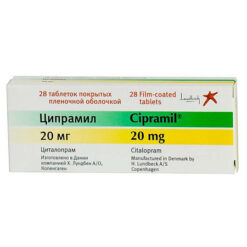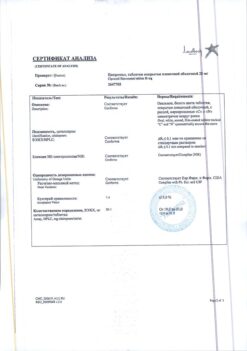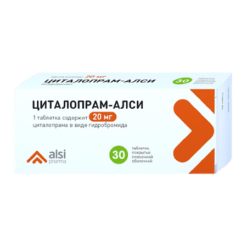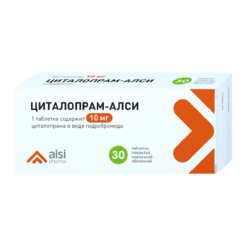No products in the cart.
Citalopram, 20 mg 30 pcs
€1.00
Out of stock
(E-mail when Stock is available)
Description
Pharmacotherapeutic group: Antidepressant.
ATX code: N06AB04.
Pharmacological properties
Pharmacodynamics
Indications
Indications
Active ingredient
Active ingredient
Composition
Composition
One film-coated tablet contains:
The active ingredient:
citalopram hydrobromide 25.0 mg, which corresponds to 20 mg of citalopram;
Excipients:
Microcrystalline cellulose 93.80 mg,
Pregelatinized starch 40.40 mg,
Magnesium stearate 0.80 mg,
Opadray II [polyvinyl alcohol (2.56) mg,
titanium dioxide (1.60) mg,
macrogol (polyethylene glycol) (1.30) mg,
talc (0.94) mg] 6.40 mg.
How to take, the dosage
How to take, the dosage
Interaction
Interaction
Cases of serotonin syndrome have been described when citalopram is used concomitantly with moclobemide and buspirone.
Controlled combinations
MAO inhibitors
The concomitant use of citalopram and MAO inhibitors may lead to serious adverse effects, including serotonin syndrome.
Serious and sometimes fatal reactions have been described in patients receiving concomitant SSRIs and monoamine oxidase inhibitors (MAOIs), including the irreversible MAOIs selegelin and the reversible MAOIs linezolid and moclobemide, and in patients who have recently stopped taking SSRIs and started an MAOI.
In some of the cases presented, signs resembling serotonin syndrome were observed.
The symptoms of citalopram interaction with IMAOs included: hyperthermia, rigidity, myoclonus, autonomic instability with rapid fluctuations in vital signs, and mental status changes that included confusion, irritability and excessive agitation, which progressed to delirium and coma.
The drugs prolonging the QT interval
Pharmacokinetic and pharmacodynamic studies of interactions between citalopram and drugs prolonging the QT interval have not been conducted. The summation of the effects of citalopram and these drugs cannot be excluded. Thus, the simultaneous use of citalopram and drugs that prolong the QT interval, such as antiarrhythmics of class IA and III, antipsychotics (eg, phenothiazine derivatives, pimozide, haloperidol), tricyclic antidepressants, some antimicrobials (e.g., sparfloxacin, moxifloxacin, erythromycin IV, pentamidine, antimalarials, especially halofantrine), some antihistamines (astemisol, misolastine), etc.д., are contraindicated.
Pimozide
In a study, a single administration of pimozide at a dose of 2 mg by subjects taking the racemic form of citalopram at a dose of 40 mg/day for 11 days resulted in increased AUC and Cmax values of pimozide, although not always. Co-administration of pimozide and citalopram resulted in an average prolongation of the QTc interval by approximately 10 ms. Given the development of interactions at low doses of pimozide, concomitant use of citalopram and pimozide is contraindicated.
Combinations requiring caution
Selegiline (selective MAO B inhibitor)
Pharmacokinetic and pharmacodynamic interaction studies of concomitant use of citalopram (20 mg/day) and selegiline (10 mg/day) (MAO B selective dose) showed no clinically significant interactions. Simultaneous use of citalopram and selegiline (at a dose greater than 10 mg/day) is not recommended.
Serotonergic drugs
Lithium and tryptophan
No pharmacodynamic interactions have been found in clinical studies of concomitant use of lithium and citalopram. However, enhanced effects have been reported with concomitant administration of SSRIs with lithium and tryptophan, so the use of such combinations should be used with caution. Blood levels of lithium are monitored routinely. Co-administration with serotonergic drugs such as tramadol and sumatriptan may lead to increased serotonergic effects. Until definitive data on possible interactions are available, combining citalopram with 5-NT receptor agonists such as sumatriptan and other triptans is not recommended.
Hypericum perforatum
The dynamic interaction of SSRIs with herbal medicines containing Hypericum perforatum may result in an increased incidence of adverse reactions. No pharmacokinetic interaction has been studied.
Anticoagulants and agents affecting blood clotting
. Caution should be used when prescribing citalopram for patients treated with anticoagulants, drugs that affect platelet function, such as nonsteroidal anti-inflammatory drugs (NSAIDs), acetylsalicylic acid, dipyridamole, and ticlopidine, or other drugs (e.g., atypical antipsychotics, phenothiazine derivatives, tricyclic antidepressants), which may increase the risk of bleeding.
Electroconvulsive therapy (ECT)
There are no clinical trial data demonstrating the risks or benefits of concomitant use of ECT and citalopram.
Alcohol
No pharmacodynamic or pharmacokinetic interactions have been found between citalopram and alcohol.
Special Instructions
Special Instructions
Periodic use in children and adolescents under 18 years of age
Antidepressants should not be prescribed to children and adolescents under 18 years of age. In clinical studies, suicidal behavior (suicide attempts and suicidal ideation) and hostility (with a predominance of aggressive behavior, confrontation and irritation) were observed more often among children and adolescents who took antidepressants than in the placebo group.
When using drugs belonging to the therapeutic group of SSRIs, including citalopram, the following should be considered:
Paradoxical anxiety
Some patients with panic disorder may experience increased anxiety at the beginning of antidepressant therapy. This paradoxical reaction usually subsides within the first two weeks of starting treatment. Low initial doses are recommended to reduce the likelihood of anxiogenic effects.
Hyponatremia
In the use of SSRIs, rare cases of hyponatremia have been reported, apparently due to inadequate secretion of antidiuretic hormone (ADH).
This reaction was generally reversible when treatment with the drug was discontinued. The risk of occurrence was higher in older women.
Suicidal ideation/suicidal thoughts or clinical deterioration
Depression is associated with an increased risk of suicidal ideation, self-harm and suicide (suicidal ideation). This risk persists until stable remission develops. Since no improvement may be noted during the first few weeks of treatment or even longer, patients should be monitored for timely detection of such improvement. Clinical experience shows that the risk of suicide increases in the early stages of recovery.
Other psychiatric disorders for which citalopram is prescribed may also be associated with an increased risk of suicidal events. In addition, these conditions may be co-occurring pathology in relation to the depressive episode. When treating patients with other psychiatric disorders, the same precautions should be followed as when treating patients with a depressive episode.
Patients with a history of suicidal tendencies or patients with significant levels of suicidal ideation prior to treatment are at greater risk for suicidal thoughts or suicide attempts, so they should be monitored closely during treatment. A mega-analysis of placebo-controlled clinical trials of antidepressants involving adult patients with psychiatric disorders found that there is an increased risk of suicidal behavior when taking antidepressants in patients younger than 25 years old compared to placebo. Medication treatment of these patients, and in particular those at high suicide risk, should be accompanied by close monitoring, especially in the early phase of treatment and during dose changes. Patients (and caregivers) should be cautioned to monitor for any signs of clinical deterioration, suicidal behavior or thoughts, and unusual behavioral changes, and to seek medical advice immediately if these symptoms occur.
Akathisia/psychomotor restlessness
The use of SSRIs/SIOSS drugs is associated with the development of akathisia, characterized by feelings of subjectively unpleasant or unbearable motor restlessness, restlessness and need to move. Often patients in this condition cannot sit or stand quietly. This condition most often occurs during the first weeks of treatment. In patients with these symptoms, increasing the dose may cause a sudden worsening of the condition.
Mania
In patients with bipolar affective disorder, a manic phase may develop. If a manic state develops, citalopram should be discontinued.
Convulsive seizures
There is a risk of seizures when taking antidepressants. In any patient, citalopram should be stopped if a seizure occurs. Citalopram should not be used in patients with unstable epilepsy; in controlled seizures, close monitoring is necessary. If seizure frequency increases, citalopram should be discontinued.
Diabetes mellitus
In patients with diabetes mellitus, the use of SSRIs may alter blood glucose concentrations. In this case, it may be necessary to adjust the dose of insulin and/or oral hypoglycemic drugs.
Serotonin syndrome
In rare cases, the development of serotonin syndrome has been reported while taking SSRIs. A combination of symptoms such as agitation, myoclonus, and hyperthermia may indicate the development of this condition. If these phenomena occur, citalopram should be discontinued immediately and symptomatic treatment should be initiated.
Serotonergic drugs
Citalopram should not be used with drugs with serotonergic effects, such as sumatriptan or other triptans, tramadol, oxytriptan and tryptophan.
Bleeding
There have been reports of skin bleeding such as ecchymosis, gynecological, gastrointestinal bleeding, and other hemorrhagic complications of the skin or mucous membranes while taking SSRIs. Caution should be exercised when concomitant use of SSRIs and drugs that affect platelet function or drugs that may increase the risk of bleeding, as well as when treating patients with a history of hemorrhagic disorders.
Electroconvulsive therapy (ECT)
Because clinical experience with concomitant use of SSRIs and electroconvulsive therapy (ECT) is limited, caution should be exercised when using citalopram and ECT concomitantly.
The reversible selective MAO A inhibitors
The concomitant use of citalopram and MAO A inhibitors is not recommended because of the risk of serotonin syndrome.
Wort of St. John’s Wort
Combined use of citalopram and preparations containing Hypericum perforatum should be avoided because it may increase the risk of adverse reactions.
Psychosis
The treatment of psychotic patients with a depressive episode may exacerbate psychotic symptoms.
See withdrawal symptoms when discontinuing SSRI therapy
See withdrawal symptoms occur quite often, especially when therapy is stopped abruptly.
The likelihood of withdrawal symptoms may depend on a number of factors, including the length of treatment, the dose of the medication, and the rate of withdrawal.The most commonly reported manifestations are: dizziness, sensory disturbances (including paresthesias), sleep disturbances (including insomnia and vivid dreams), agitation or anxiety, nausea and/or vomiting, tremor, confusion, sweating, headache, diarrhea, palpitations, emotional lability, irritability and visual disturbances. Usually, these manifestations are mild to moderate, but in some patients they may be severe.
In general, these effects usually occur within the first few days of withdrawal, but there have been some reports of these conditions occurring in patients who have accidentally missed their next dose.
In most cases, these problems resolve within 2 weeks, although some patients may have symptoms for 2 to 3 months or longer. Therefore, it is recommended that the dose of citalopram be gradually reduced over a period of several weeks to several months before ending the citalopram regimen, depending on the patient’s condition.
QT interval prolongation
Citalopram has been found to cause dose-dependent prolongation of the QT interval. Post-registration, cases of QT interval prolongation and ventricular arrhythmias, including torsade de pointes, have been reported predominantly in female patients with hypokalemia or pre-existing QT interval prolongation or other cardiac conditions.
The drug is recommended with caution in patients with significant bradycardia, recent myocardial infarction, or decompensated heart failure.
Electrolyte disturbances, such as hypokalemia and hypomagnesemia, increase the risk of malignant arrhythmias and therefore should be corrected before starting citalopram therapy.
In patients with compensated heart disease, an ECG study should be performed before starting treatment.
In case of any signs of cardiac arrhythmias during treatment with citalopram, it is necessary to cancel it and perform ECG study.
Citalopram has minimal or moderate ability to affect the ability to drive and operate machinery. Psychoactive medications may affect decision-making and the ability to respond to emergencies. Patients should be advised of the potential effects on driving and operating machinery.
Contraindications
Contraindications
Side effects
Side effects
The undesirable effects observed with citalopram are usually mild and transient in nature. They occur most frequently in the first or second week of treatment and usually subside considerably as therapy continues. A dose dependence has been found for the following reactions: sweating, dry mouth, insomnia, somnolence, diarrhea, nausea and weakness.
The following categories are used to describe the frequency of adverse reactions: very common (â¥1/10), common (â¥1/100 and <1/10), infrequent (â¥1/1000 and <1/100), rare (â¥1/10000 and <1/1000), very rare (<1/10000), frequency unknown (cannot be estimated from existing data). The following adverse reactions are listed in order of clinical significance.
Blood and lymphatic system disorders: rare: bleeding; frequency unknown: thrombocytopenia.
Immune system disorders: frequency unknown: hypersensitivity, anaphylactic reactions.
Endocrine system disorders: frequency unknown: insufficient secretion of antidiuretic hormone (ADH).
Metabolic and nutrition disorders: often: decreased appetite, decreased body weight; infrequent: increased appetite, increased body weight; rare: hyponatremia;
frequency unknown: hypokalemia.
Mental disorders: common: agitation, decreased libido, anxiety, nervousness, confusion, anorgasmia (in women), unusual dreams; infrequent: aggression, depersonalization, hallucinations, mania; common unknown: panic attacks, bruxism, anxiety, suicidal thoughts, suicidal behavior.
Cases of suicidal thoughts and behavior have been noted during citalopram therapy and immediately after treatment withdrawal.
Nervous system disorders: very common: somnolence, insomnia; common: tremor, paresthesia, dizziness, attention deficit; infrequent: fainting; rare: grand seizures, dyskinesia, taste disorders; frequency unknown: seizure disorders, serotonin syndrome, extrapyramidal disorders, akathisia, movement disorders.
Visual disorders: infrequent: mydriasis (dilation of the pupils); frequency unknown: visual disturbances.
Hearing and labyrinth disorders: common: tinnitus.
Cardiac disorders: very common: palpitations; infrequent: bradycardia, tachycardia; frequency unknown: prolongation of QT interval on electrocardiogram, ventricular arrhythmia, including torsade de pointes, orthostatic hypotension.
Respiratory system, chest and mediastinum disorders: common: yawning; frequency unknown: nose bleed.
Gastrointestinal disorders: very common: dry mouth, nausea; common: diarrhea, vomiting, constipation; frequency unknown: gastrointestinal bleeding (including rectal bleeding).
Liver and biliary tract disorders: rare: hepatitis; frequency unknown: abnormalities of liver function parameters.
Skin and subcutaneous tissue disorders: very common: increased sweating; common: itching; infrequent: urticaria, alopecia, rash, purpura, photosensitization; common unknown: ecchymosis, angioedema.
Muscular and connective tissue disorders: common: myalgia, arthralgia.
Kidney and urinary tract disorders: frequency unknown: urinary retention.
Gender and mammary gland disorders: frequently: impotence, impaired ejaculation, lack of ejaculation; infrequently: menorrhagia (in women); frequency unknown: galactorrhea, metrorrhagia (uterine bleeding), priapism (in men).
General disorders and disorders at the site of administration: frequently: weakness; infrequently: edema; rarely: hyperthermia.
Epidemiological studies predominantly involving patients aged 50 years and older have shown the existence of an increased risk of bone fractures in patients taking SSRIs and tricyclic antidepressants. The mechanism leading to this risk is unknown.
Indications of QT interval prolongation and ventricular arrhythmias, including torsade de pointes, have been reported in the post-registration period, predominantly in female patients with hypokalemia or pre-existing QT interval prolongation and other heart disease.
The withdrawal of citalopram (especially abrupt) often results in “withdrawal” symptoms. The most common are dizziness, sensory disturbances (including paresthesias), sleep disturbances (including insomnia and intense dreaming), agitation or anxiety, nausea and/or vomiting, tremors, confusion, sweating, headache, diarrhea, palpitations, emotional instability, irritability, and visual disturbances. As a rule, these effects are mild to moderate and pass quickly, however, in some patients they may appear in a more acute form and/or for a longer time. If citalopram therapy is no longer required, a gradual withdrawal of the drug by reducing its dose is recommended.
Overdose
Overdose
Pregnancy use
Pregnancy use
Similarities
Similarities
Additional information
| Shelf life | 3 years. Do not use after the expiration date stated on the package. |
|---|---|
| Conditions of storage | Store in the dark place at temperatures under 25 ° C. Keep out of reach of children. |
| Manufacturer | Pranapharm, Russia |
| Medication form | pills |
| Brand | Pranapharm |
Other forms…
Related products
Buy Citalopram, 20 mg 30 pcs with delivery to USA, UK, Europe and over 120 other countries.


















